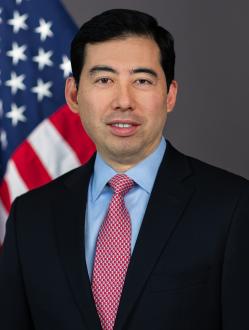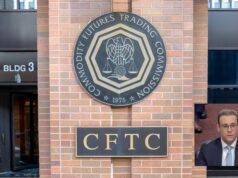As the United States undergoes a leadership transition with President-elect Donald Trump preparing to take office, one name stands out in the financial regulation arena: Mark Uyeda. Currently serving as a Commissioner at the U.S. Securities and Exchange Commission (SEC), Mark Uyeda is widely seen as the front-runner to replace outgoing SEC Chair Gary Gensler. His nomination signals a possible paradigm shift in U.S. crypto regulation, aligning with Trump’s promise to end what he terms the “war on crypto.”
A Departure from the Enforcement-Heavy Era
Uyeda has been a vocal critic of the SEC’s aggressive enforcement actions under Gensler, whose tenure was marked by a clampdown on cryptocurrency firms. While Gensler emphasized investor protection and regulatory oversight, his approach drew backlash for creating an environment many in the industry viewed as hostile to innovation. Uyeda’s potential ascension to the chairmanship is seen as a departure from this enforcement-centric model.
Instead, Uyeda advocates for a regulatory framework grounded in clarity and consistency. In public statements and speeches, he has called for precise definitions of what constitutes a security in the context of cryptocurrencies. He also emphasized the need for tailored regulations that do not stifle innovation.
Pragmatic Reform: Uyeda’s Three-Step Vision
Central to Uyeda’s appeal is his three-step plan for cryptocurrency regulation, which has been widely discussed in policy circles:
- Defining Digital Assets Clearly: Uyeda argues that regulatory ambiguity has created unnecessary challenges for blockchain projects. His plan seeks to establish clear parameters to differentiate cryptocurrencies under SEC jurisdiction from those classified as commodities or other asset types.
- Implementing Regulatory Sandboxes: Uyeda champions the idea of creating controlled environments where blockchain startups can innovate under regulatory supervision. This model, already used in some international markets, would allow crypto projects to test their technology while ensuring compliance.
- Inter-Agency Collaboration: Uyeda recognizes the overlapping responsibilities of regulatory bodies like the SEC and the Commodity Futures Trading Commission (CFTC). Therefore, he advocates for enhanced collaboration to create a cohesive approach to crypto regulation.
Industry Optimism vs. Investor Protection Concerns
Blockchain advocates and financial innovators have welcomed Uyeda’s potential appointment. His approach is seen as an opportunity to position the U.S. as a global leader in blockchain technology by fostering a more innovation-friendly regulatory environment. Industry leaders argue that his policies could reduce the exodus of blockchain projects to countries with clearer regulations.
However, Uyeda’s critics question whether his policies might tip the scales too far in favor of industry interests. Investor protection remains a cornerstone of SEC oversight. Some fear that Uyeda’s pro-crypto stance could create vulnerabilities in an already volatile market. Striking a balance between fostering innovation and ensuring market integrity will likely be his greatest challenge if confirmed as SEC Chair.
>>> Read more: SEC Chair Nominee Debate: Crypto vs. Tradition
Trump’s Vision and Uyeda’s Role
Uyeda’s potential appointment aligns closely with Trump’s broader economic agenda, which emphasizes deregulation and fostering innovation in emerging technologies. Trump’s commitment to ending the “war on crypto” positions Uyeda as a key player in advancing this vision. While the details of Trump’s crypto strategy remain to be fully articulated, Uyeda’s leadership at the SEC would likely be a cornerstone of these efforts.
The Road Ahead
Mark Uyeda’s pragmatic approach to crypto regulation has ignited debate across the financial and political spectrum. Whether his policies can simultaneously satisfy the demands of innovation, investor protection, and market stability remains to be seen. As the crypto industry watches closely, Uyeda’s potential confirmation could mark a pivotal moment for U.S. leadership in blockchain and alternative assets.
>>> Read more: Scott Bessent – Crypto Advocate Nominated for Treasury Secretary
His appointment would not only redefine the SEC’s approach to cryptocurrency but also reflect the evolving priorities of U.S. financial regulation in a rapidly changing digital economy.
Readers’ frequently asked questions
What exactly is a regulatory sandbox, and how would it work for cryptocurrencies?
A regulatory sandbox is a controlled environment where new technologies or financial products can be tested under close supervision by regulators. In the context of cryptocurrencies, it would allow blockchain startups to trial their platforms, tokens, or decentralized applications (dApps) without the immediate risk of violating regulations. For instance, a company developing a cryptocurrency-based payment system could test it with real users under specific guidelines set by the SEC. This would help regulators understand the technology and its implications. At the same time, it gives the company a chance to comply with requirements in a flexible manner. By fostering innovation in this way, regulatory sandboxes aim to strike a balance between protecting consumers and enabling technological progress.
Why does the SEC regulate some cryptocurrencies while others are not under its jurisdiction?
The SEC’s jurisdiction depends on whether a cryptocurrency is classified as a security under U.S. law. A security is an investment contract where people invest money with the expectation of profits primarily from the efforts of others. If a cryptocurrency falls into this category, it is subject to SEC regulations. For example, if a token is sold to fund a project with the promise of returns for buyers, it could be deemed a security. Other cryptocurrencies, like Bitcoin and Ethereum, are considered decentralized assets. They are usually classified as commodities, regulated by the Commodity Futures Trading Commission (CFTC) instead of the SEC. Mark Uyeda’s proposal to clarify these classifications aims to eliminate the confusion surrounding these distinctions.
How could Mark Uyeda’s leadership affect the average cryptocurrency investor?
If Mark Uyeda becomes SEC Chair and implements his proposed reforms, it could have several impacts on everyday cryptocurrency investors. First, clearer regulations could reduce uncertainty. They would make it easier for investors to understand which tokens are compliant and safer to invest in. Regulatory sandboxes could lead to the development of more innovative and reliable blockchain projects, potentially increasing the availability of legitimate investment opportunities. However, his pro-industry stance might also pose risks. If investor protections are not adequately enforced, it could expose individuals to poorly regulated or high-risk ventures. Investors would still need to conduct thorough research and remain cautious, especially in such a volatile market.
What Is In It For You? Action Items You Might Want to Consider
Stay Updated on Regulatory Developments
As Mark Uyeda emerges as the frontrunner for SEC Chair, his potential leadership could significantly reshape U.S. crypto regulations. Traders should follow updates on his nomination and policy proposals, especially his plans for regulatory clarity and sandboxes. Understanding these changes could help you anticipate market trends and make informed trading decisions.
Evaluate Tokens for Regulatory Risk
Given Uyeda’s focus on clearly defining which cryptocurrencies fall under SEC jurisdiction, it’s wise to reassess your portfolio for assets that might face increased scrutiny or benefit from clearer regulations. Consider prioritizing projects that demonstrate compliance or transparency, as these may perform better under a reformed regulatory environment.
Explore Innovation-Friendly Markets
If regulatory sandboxes become a reality, they could give rise to innovative blockchain projects and new trading opportunities. Keep an eye on emerging projects that participate in these environments. They might offer early-stage investment opportunities with lower regulatory risks compared to projects operating outside compliance.











[…] U.S. regulatory landscape. Since the 2024 elections and the appointment of new leadership under Acting Chair Mark Uyeda, the SEC has signaled a move towards clearer, industry-friendly regulations rather than pursuing […]
[…] arrival follows months of transition at the SEC. Under interim Chair Mark Uyeda, the Commission had already begun retreating from the aggressive enforcement strategies that […]